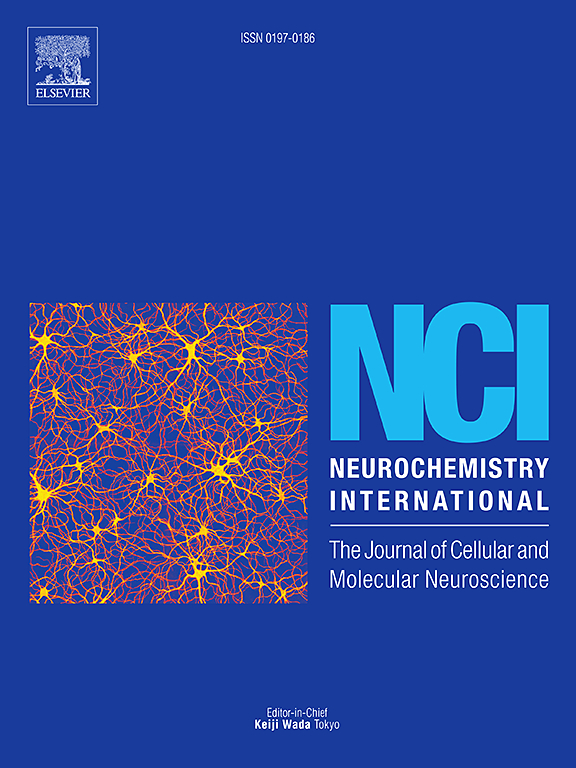联合补充短链脂肪酸可以减少Tau在T181、T231和S396位点的过度磷酸化,并通过调节HDAC和Keap1改善化学诱导AD小鼠模型的认知障碍
IF 4
3区 医学
Q2 BIOCHEMISTRY & MOLECULAR BIOLOGY
引用次数: 0
摘要
阿尔茨海默病(Alzheimer's disease, AD)以β-淀粉样蛋白沉积和Tau蛋白过度磷酸化为病理特征,以记忆丧失和认知功能障碍为主要临床表现。近年来,阿尔茨海默病的发病率逐渐增加。短链脂肪酸(SCFAs)是宿主-肠道微生物相互作用的关键效应分子,在维持中枢神经系统稳态中起着至关重要的作用。本研究采用AlCl3/D-gal诱导法建立AD小鼠模型。采用Morris水迷宫等行为学测试评估混合SCFA干预对AD模型小鼠空间学习记忆的影响。采用酶联免疫吸附试验(ELISA)和商用试剂盒定量测定脑和结肠组织中促炎细胞因子水平和氧化应激相关酶活性。Western blot、免疫组织化学和免疫荧光分析关键蛋白的表达水平。结果表明,SCFAs可显著缓解AD模型的认知功能障碍,降低T181、T231和S396位点的Tau过度磷酸化,抑制促炎细胞因子释放,增强抗氧化能力,但对AD模型中升高的Aβ水平无逆转作用。从机制上讲,SCFAs抑制胶质细胞活化,上调血脑屏障中的MCT-1和紧密连接蛋白,增强肠脑屏障完整性,可能调节小分子跨屏障运输。此外,检测相关蛋白表达发现,SCFAs在AD小鼠模型中激活HDAC1,抑制HDAC3和Keap-1过表达。这些发现表明,SCFAs可能调节阿尔茨海默病大脑的表观遗传修饰,发挥神经保护作用。这项研究提供了新的证据,支持共生微生物来源的scfa在缓解AD方面的潜力。本文章由计算机程序翻译,如有差异,请以英文原文为准。
Combined supplementation of short-chain fatty acids reduces hyperphosphorylation of Tau at T181,T231 and S396 sites and improves cognitive impairment in a chemically induced AD mouse model via regulation of HDAC and Keap1
Alzheimer's disease (AD) is characterized by the pathological hallmarks of β-amyloid deposition and Tau protein hyperphosphorylation, with memory loss and cognitive dysfunction as its primary clinical manifestations. The incidence of AD has been progressively increasing in recent years. Short-chain fatty acids (SCFAs), key effector molecules in host-gut microbial interactions, play a crucial role in maintaining central nervous system homeostasis. In this study, AD mouse model was established via AlCl3/D-gal induction. The effects of mixed SCFA intervention on spatial learning and memory in AD model mice were assessed using behavioral tests, including the Morris Water Maze. Levels of pro-inflammatory cytokines and activities of oxidative stress-related enzymes in brain and colon tissues were quantified using ELISA and commercial kits. Key protein expression levels were analyzed by Western blot, immunohistochemistry, and immunofluorescence. Results demonstrated that SCFAs significantly alleviated cognitive dysfunction in AD model, reduced Tau hyperphosphorylation at T181, T231 and S396 sites, suppressed pro-inflammatory cytokine release, and enhanced antioxidant capacity, but with no reversal in elevated Aβ levels in AD model. Mechanistically, SCFAs inhibited glial cell activation, upregulated MCT-1 and tight junction proteins in the blood-brain barrier and strengthened gut-brain barrier integrity, potentially regulating small molecule trans-barrier transport. Furthermore, examination of relevant protein expressions revealed that SCFAs activated HDAC1 and inhibited overexpressed HDAC3 and Keap-1 in AD mice model. These findings suggest that SCFAs may regulate epigenetic modifications in the brain of AD to exert neuroprotective effects. This study provides novel evidence supporting the potential of symbiotic microbe-derived SCFAs in alleviating AD.
求助全文
通过发布文献求助,成功后即可免费获取论文全文。
去求助
来源期刊

Neurochemistry international
医学-神经科学
CiteScore
8.40
自引率
2.40%
发文量
128
审稿时长
37 days
期刊介绍:
Neurochemistry International is devoted to the rapid publication of outstanding original articles and timely reviews in neurochemistry. Manuscripts on a broad range of topics will be considered, including molecular and cellular neurochemistry, neuropharmacology and genetic aspects of CNS function, neuroimmunology, metabolism as well as the neurochemistry of neurological and psychiatric disorders of the CNS.
 求助内容:
求助内容: 应助结果提醒方式:
应助结果提醒方式:


